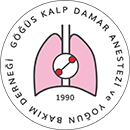

Volume: 25 Issue: 3 - 2019
| 1. | Cover Page I (817 accesses) |
| 2. | Contents Pages II - V (838 accesses) |
| 3. | Publication Policies and Writing Guide Pages VI - XI (704 accesses) |
| RESEARCH ARTICLE | |
| 4. | Usual suspect: Myocardial Injury and Infarction After Non-Cardiac Surgery Eda Balcı, Ülkü Sabuncu, Aslı Demir, Mustafa Bindal, İpek Zöhre, Cavit Ceylan, Ayşegül Özgök doi: 10.5222/GKDAD.2019.52244 Pages 145 - 151 (1282 accesses) INTRODUCTION: It was observed that postoperative 30-day mortality increased due to symptomatic and silent myocardial damage and this risk continued in the long term. The primary aim of our study was to investigate the history of myocardial infarction in a 1-year period for patients aged 45 years and older who underwent urological surgery in our hospital. The second aim of this study was to determine how accurate the patients in the early postoperative period might be at risk for myocardial infarction and to determine how a cardiac follow-up was performed. METHODS: The files of 900 patients aged 45 years and over who underwent urological surgery were analyzed retrospectively. Preoperative comorbidities and myocardial infarction were recorded. Postoperative Hs-troponinT values (if studied) were reached. Patients were contacted by phone for 1 year mortality and cardiac event investigation. RESULTS: 608 patients were included in our study. In the postoperative one-year period, patients were diagnosed with MI at a rate of 6.7% (41 patients). This rate was found to be 10.8% in patients 65 years and older. The number of patients with 30-day mortality due to MI was 3 (0.49%). The number of patients with 1-year mortality was found to be 25 (4.1%). 26 patients had CAD, 12 patients had DM, 11 patients had CHF. However, postoperative ECG, CK-MB and troponin were evaluated in 7 of these patients and cardiology consultation was requested. DISCUSSION AND CONCLUSION: The results of this study show that we are insufficient to detect perioperative silent and obvious myocardial damage. We think that postoperative troponin follow-up is very important especially in patients with advanced elderly and co-morbidities. We recommend performing cardiac follow-ups in risky patients even if they have had daily surgery. Because simple cardiac follow-ups (troponin, ECG, pain follow-up) are important for advanced cardiac interventions (cardiac catheterization, percutaneous cardiac interventions, surgery, intensive care) that may be required in patients. |
| 5. | Duration of acute kidney injury after cardiac surgery effects mortality Gülçin Patmano, Mehmet Tercan, Ahmet Kaya, Durdu Karakız doi: 10.5222/GKDAD.2019.04909 Pages 152 - 159 (865 accesses) INTRODUCTION: Acute Kidney Injury (AKI) development is not a rare complication after cardiac surgery, and is often associated with a high risk of morbidity and mortality. In-hospital mortality rates of patients in need of dialysis can reach up to %70. Our aim was to determine the AKI developmental risk factors and the results of AKI development by examining the cases of AKI developed after cardiac surgeries performed in our hospital in 8 years period. METHODS: 594 patients who underwent cardiovascular surgery between January 2010-September 2018 were included in the study retrospectively. Clinically important ones among the significant data divided into three groups again as 1-3 days AKI (Group 1), 3-7 days AKI (Group 2) and ≥7 days AKI (Group 3) according to AKI days. RESULTS: AKI was observed in 31.1% of the patients. Duration of intubation(p <0.001), duration of intensive care unit(ICU) stay (p <0.001), duration of hospital stay (p <0.001) and exitus day average(p <0.001) were significantly longer in this patient group. Duration of ICU stay (p = 0.001; p <0.001, respectively) and duration of hospital stay (p <0.001; p = 0.001, respectively) was significantly longer in AKI group, in all sub-groups except for Group 1. Exitus day average was longer just in Group 3 (p = 0.002). DISCUSSION AND CONCLUSION: AKI development is one of the important factors affecting mortality and morbidity after cardiac surgery. It is directly proportionate not only to AKI development after cardiac surgery, but also fundamentally to duration of AKI, duration of ICU stay, duration of hospital stay and mortality. |
| 6. | The comparison of anatomical description and ultrasound-guided percutaneous central venous catheter insertion methods single center experience Yahya Yıldız, Mustafa Özer Ulukan, Emir Cantürk, Yaşar Gökhan Gül, Korhan Erkanli, Yavuz Demiraran, Murat Uğurlucan, Halil Türkoğlu doi: 10.5222/GKDAD.2019.16056 Pages 160 - 166 (1014 accesses) INTRODUCTION: With the widespread use of ultrasound by the pediatric cardiac anesthesiologist, the number of successful interventions with time and material saving increased and complications decreased. In this study, we compared the methods of insertion of two different methods, anatomic definition (AD) and ultrasonography (US) with percutaneous central venous catheter (CVC). METHODS: A total of 293 cases, under 10 kg, randomly, retrospectively; AD (n=151) and US (n=142) were divided into two groups. The CVC was inserted into the right/left internal jugular vein (IJ), the right/left femoral vein (FV), and the right/left subclavian vein (SCV). Compared parameters: demographics, catheter insertion site, procedures, durations, number of surgical catheter insertion and complications. RESULTS: Demographic data of the groups; in age (1 day-4.5 years), weight (560 gr-10 kg), height (23-103 cm) and gender was no difference (p≥0.05). CVC insertion in %: right/left IJ, right/left FV, right SCV, surgical femoral vein/right atrium; In the AD at 82/6/6/2/2/2, in US 89/9/1/0/0/0 (p<0,05). The number of CVC interventions were 1-26 (6.7±17.7) times in the AD group and 1-4 (1.23±0.5) in the US group (p<0.05). The duration (minute) of CVC insertion was 16-231 (45.2±47.5) in the AD group and 11-82 (16.1±13.8) in the US group (p<0.05). Complications was: bleeding, hematoma, circulatory disorder, nerve damage, prolonged hospitalization, mortality in %; AD 11/9/7/3/4/1, US 1/2/0/0/0/0 (p<0.05). DISCUSSION AND CONCLUSION: Catheterization in pediatric cardiac anesthesia can be done by anatomical description or ultrasound; but with ultrasound guidance; We believe that it causes a decrease in the complications while leading to an improvement in time and successful intervention. |
| 7. | Albumin, globulin and albumin-globulin ratio as a predictor of mortality, morbidity after Fontan operations Ömer Faruk Savluk, Fusun Güzelmeriç, Yasemin Yavuz, Fatma Ukil, Abdullah Arif Yilmaz, Berra Zumrut Tan Recep, Hakan Ceyran doi: 10.5222/GKDAD.2019.20633 Pages 167 - 174 (1006 accesses) INTRODUCTION: Assess of the albumin, globulin score and albumin to globulin ratio (AGR) as a predictor of mortality and morbidity of patients with underwent Fontan procedure. METHODS: In a retrospective study, we evaluated serum albumin, globulin concentrations, and albumin- globulin ratio of 56 children with underwent Fontan procedure.Patients divided into two groups. Group 1 consisted of 44 patients who were discharged, and Group 2 consisted of 12 patients who were deceased after surgery.Patients' preoperative and postoperative serum albumin, globulin and albumin globulin rates (AGR) were measured. Receiver-operating characteristic (ROC) curve analysis was used to determine the optimum cut-off levels of the postoperative albumin and AGR to predict mortality. RESULTS: 12 patients died during the intensive care unit stay following surgery.The preoperative albumin and globulin values were not different between groups but the postoperative albumin, and albumin-globulin ratio were found to be significantly different between groups (respectively, p = 0.002, p = 0.03) Using a cut-off value of 3,46, the postoperative albumin predicted mortality with a sensitivity of 79% and specificity of 83%.Using a cut-off value of 1,67, the postoperative AGR predicted mortality with a sensitivity of 75% and specificity of 89%.multivariate models, the postoperative albumin<3,46 was associated with a eleven-fold increase in the risk of mortality (OR 11;%95CI 0,27-1,10; p=0,002), the postoperative AGR<1,67 was associated with a four-fold increase in the risk of mortality (OR 4,4;%95CI 0,016-0,78;p=0,04). DISCUSSION AND CONCLUSION: Postoperative albumin and AGR are a convenient and effective tool to predict the overall mortality and morbidity in patients undergoing Fontan operations. |
| 8. | Side Graft Axillary Artery Cannulation in Proximal Thoracic Aortic Surgery Semih Murat Yücel, Serkan Burc Deser, Mustafa Kemal Demirağ doi: 10.5222/GKDAD.2019.69672 Pages 175 - 180 (906 accesses) INTRODUCTION: The most preferred arterial cannulation region during cardiopulmonary bypass is ascending aorta. However, alternative arterial cannulation regions may be needed in the surgical treatment of pathologies involving proximal thoracic aortic segments. For this purpose, femoral artery is frequently used in past years, but nowadays axillary artery cannulation is widely used. Axillary artery cannulation can be performed either directly/indirectly. In this study, we aimed to evaluate outcomes of patients who were operated due to proximal thoracic aortic pathology with side graft axillary artery cannulation. METHODS: Forty-six patients who operated due to proximal thoracic aortic pathologies with side graft axillary cannulation technique between January 2008- December 2018 in our hospital were evaluated retrospectively. RESULTS: Side graft axillary cannulation technique was successfully applied in all patients. Axillary artery injury did not occur in any patient. No permanent neurological deficit developed at the right upper extremity and there was no infection at cannulation region in any patient. There were 10 (21.7%) patients with hospital mortality. DISCUSSION AND CONCLUSION: Nowadays, increasingly preferred peripheral cannulation method is axillary cannulation for proximal thoracic aortic operations. The most important antadvantages of this method are presence of antegrade cerebral/systemic perfusion and absence of retrograde embolization risk. Local complications (e.g. brachial plexus/axillary artery injury) due to cannulation of the axillary artery may occur. Using side graft axillary cannulation technique can reduce risk of developing these complications. In our study, we did not encounter any local/ systemic complications due to preferred cannulation region in our patients who were operated by side graft axillary artery cannulation technique. |
| 9. | Ventilator Associated Pneumonia After Open Heart Surgery: Risk Factors Abbas Köse, Nurgul Yurtseven, İpek Yakın Düzyol doi: 10.5222/GKDAD.2019.00719 Pages 181 - 189 (972 accesses) INTRODUCTION: Ventilator-associated pneumonia (VAP) are common infections in intensive care units. The high mortality rate is important due to prolonged hospital stay and increased hospital costs. In this study, we aimed to determine the risk factors associated with VAP in patients who had undergone open heart surgery. METHODS: In this study, a total of 599 patients (178 female, 421 male) who underwent elective open heart surgery were prospectively included in this study. Patients who could not be extubated after 48 hours were divided into two groups. Group 1: Patients with clinical suspicion of VAP and endotracheal aspirate (ETA) growth (29 patients) were accepted as Group 2: Control group (570 patients). RESULTS: In our study group consisting of patients who had undergone cardiac surgery, gender, obesity, diabetes mellitus (DM), hypertension, non-risk factors were not detected as age, Chronic Obstructive Pulmonary Disease (COPD), Pulmonary Hypertension, low ejection fraction (EF), long duration of clamp and pump duration, inotropic support, intra-aortic balloon pump (IABP) and use of hemofiltration, atrial fibrillation, reintubation, enteral nutrition with nasogastric tube, reoperation, neurological dysfunction, steroid use, blood and blood product use, hypoalbuminemia and presence of decubitus ulcer VAP risk factors. DISCUSSION AND CONCLUSION: In the patient population consisting of patients with cardiac surgery, keeping the invasive mechanical ventilator support as short as possible, reducing the need for reintubation by extubation in optimal time, ensuring complete haemodynamic stability, preoperative preparation of the patient preoperatively, prevention of postoperative haemodynamic instability during surgery, and reduction of VAP. |
| 10. | The effect of patient position and pneumoperitoneum on perfusion index and pleth variability index in patients undergoing laparoscopic cholecystectomy Reyhan Arslantas, Mustafa Kemal Arslantaş, Gülbin Töre Altun, Pelin Corman Dincer doi: 10.5222/GKDAD.2019.80958 Pages 190 - 197 (1667 accesses) INTRODUCTION: Patient position and pneumoperitoneum during laparoscopic surgery effect hemodynamic parameters by changing intrathoracic pressure. The aim of the study is to investigate the effect of reverse Trendelenburg and pneumoperitoneum on perfusion index (PI) and pleth variability index (PVI) during laparoscopic surgery. METHODS: Seventy-five patients who would undergo elective laparoscopic cholecystectomy under general anaesthesia for cholelithiasis in two centres were recruited in this prospective observational study. Respiratory and hemodynamic parameters, PI and PVI values were recorded prior and after the anaesthesia induction, during reverse Trendelenburg position, during pneumoperitoneum and after deflation RESULTS: Due to haemodynamic instability that required medication 7 patients were excluded from the study. PI values increased after general anesthesia induction (P<0.001) but PVI values didnt change (P>0,05). No significant change is observed in PI values with the patient position and pneumoperitoneum. PVI values measured in reverse Trendelenburg position and pneumoperitoneum were higher than post-entubation values (P<0,05) and post-deflation values were similar to baseline values (P>0,05). DISCUSSION AND CONCLUSION: PI values increase, and PVI is not affected during general anaesthesia. Reverse Trendelenburg position and pneumoperitoneum do not cause a change in PI values, whereas PVI values increase These changes should be taken into consideration when fluid management is done by PI and PVI monitoring during surgeries done with pneumoperitoneum or in reverse Trendelenburg position. |
| CASE REPORT | |
| 11. | Locking Placement And Surgical Management In Sternal Fractures: Case Report AYSUN Kosıf, Onur Derdiyok, Serdar Evman doi: 10.5222/GKDAD.2019.50490 Pages 198 - 201 (847 accesses) Flail chest is the most severe form of blunt thoracic trauma and is defined as the disruption of the sternum fractures or costochondral joints as a result of at least two fractures of three or more of the ribs on the anterior or lateral side of the chest wall. Life-threatening physiopathologic changes can affect the clinical condition of patients at any moment. Flail chest is defined as the movement of the broken segment to the inside while breathing while moving to the outside. Surgical is the only option in the case of significant deformity involving the chest wall, inconsistent breathing dynamics, lung or diaphragmatic injury, and prolonged mechanical ventilation. In this article, we presented a reconstruction of the chest wall with AO-ASIF (Arbeitsgemeindschaft fur Osteosynthesefragen) osteosynthesis plate, which we performed in a patient with post-traumatic sternal fracture and paradoxal respiration. |
| 12. | Intravenous Lipid Emulsion Treatment After High Dose Propafenone Intake for suicide: Case report Sevim Temiz, Hakan Akelma, Cem Kıvılcım Kaçar, Osman Uzundere, Sedat Kaya, Abdulkadir Yektaş doi: 10.5222/GKDAD.2019.48278 Pages 202 - 205 (1658 accesses) Propafenone is a class 1C antiarrhythmic drug. It acts mainly by blocking calcium channel. Propafenone is a lipophilic drug and more than 90% of the drug bound to plasma proteins. IV Lipid Emulsion forms a separate lipid compartment in the plasma, keeps lipophilic drugs this compartment and it reduces the side effects of these drugs. We aimed to demonstrate the efficacy of IV Lipid Emulsion treatment in this case with propafenon intoxication. |
| 13. | Norepinephrine extravasation and tissue damage in the intensive care patient Ahmet Şen, Yavuz Akıntürk, AYŞE Acar Dayıoğlu, Selma Özkan doi: 10.5222/GKDAD.2019.81567 Pages 206 - 209 (1251 accesses) Extravasation may occur due to different types of medication, infusion and patient. Therefore, it is necessary to be careful in the infusion of the acidic vasopressors. Long-term bed dependent patient was taking norepinephrine due to hemodynamic impairment. We have attempted to present the extravasation injury caused by peripheral vasopressor for a short time after the development of catheter infection. |
| 14. | Tracheostomy experience in two patients with cranial bleeding after LVAD (left ventricular assist device) Mine Altınkaya Çavuş, Şerife Gökbulut Bektaş, Sema Turan doi: 10.5222/GKDAD.2019.08860 Pages 210 - 215 (2036 accesses) Background: The number of heart transplantations has decreased in recent years and the number of implanted left ventricular assist devices (LVADs) has increased significantly. In addition, due to the current condition of these patients, the duration of stay in intensive care and mechanical ventilation increases. Percutaneous dilatational tracheostomy (PDT) is applied to these patients due to the need for prolonged mechanical ventilation. Complications may occur in this period due to the use of anticoagulant therapy. Case presentation: Our cases were 2 patients who had anticoagulant and antiplatelet therapy due to LVAD, who had hemorrhagic SVO and had prolonged MV. This leads to the necessity of tracheostomy. Conclusions: Bleeding complications cannot be excluded in these patients who have to take anticoagulant therapy. |
| 15. | Large Intraatrial Mass as a Cause of Acute Respiratory Failure: An Anesthesiologic Approach to Preserve Cardiorespiratory Cycle and Literature Review Emre Sertaç Bingül, Başar Erdivanlı, Saban Ergene, Hizir Kazdal doi: 10.5222/GKDAD.2019.04809 Pages 216 - 222 (877 accesses) Gynecologic tumors originating from great vessels are observed quite rarely. Migrating along with the bloodstream; they can reach cardiac chambers in chronical process. As they reach to symptomizing sizes, urgent surgery may be needed. These patients, who are difficult in both surgical and anesthesiologic aspects, are open to hemodynamic and respiratory complications. In this case report; we tried to describe anesthesiologic management of an intracardiac located gynecologic tumor surgery patient, who had been presented with acute respiratory failure, in the light of literature. |

















